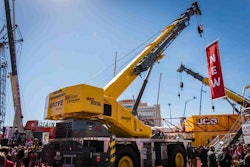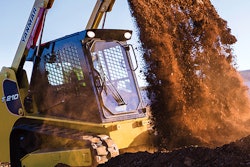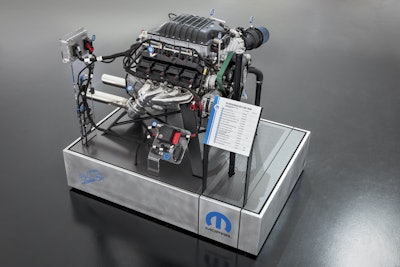
Mopar dropped some jaws at this year’s SEMA show with the introduction of the first 1,000-horsepower crate engine ever produced by an OEM.
And yes, it’s a HEMI.
The new 426 Supercharged Mopar crate engine, aka “Hellephant,” also boasts an impressive 950 lb.-ft. of torque. The engine has 4 inches of stroke and bore specs at 4.125 inches.
Mopar says it features an improved supercharger with a high-efficiency rotor mounted on an aluminum block for weight savings.
The engine’s model number and nickname are callbacks to both the original 426 HEMI, introduced in 1964 and nicknamed the “Elephant” due to its power and size, and the Mopar “Hellcrate” engine kit revealed at SEMA 2017. The Hellcrate is a 6.2-liter kit with 707 horsepower and 650 lb.-ft. of torque.
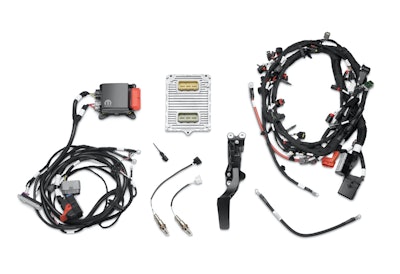 The “Hellephant” 426 Supercharged Mopar Crate HEMI® Engine Kit. The kit includes a powertrain control module (PCM), power distribution center, engine wiring harness, chassis harness, accelerator pedal, ground jumper, oxygen sensors, charge air temperature sensors, fuel pump control module and cam bus interface device.
The “Hellephant” 426 Supercharged Mopar Crate HEMI® Engine Kit. The kit includes a powertrain control module (PCM), power distribution center, engine wiring harness, chassis harness, accelerator pedal, ground jumper, oxygen sensors, charge air temperature sensors, fuel pump control module and cam bus interface device.Mopar says dropping the Hellephant into a vehicle is “almost” turnkey with the engine kit, which includes a powertrain control module (PCM), power distribution center, engine wiring harness, chassis harness, accelerator pedal, ground jumper, oxygen sensors, charge air temperature sensors, fuel pump control module and cam bus interface device. The PCM is unlocked and tuned to pump out the full 1,000 hp and 950 lb.-ft. torque.
The engine assembly includes a water pump, flywheel, front sump oil pan, supercharger with throttle body, fuel injectors and coil packs.
Mopar will also offer an essential Front End Accessory Drive (FEAD) Kit, which includes an alternator, power-steering pump, belts, pulleys and more, and is among additional engine accessory hardware components available to assist in installing the Hellephant.
Because the engine assembly and kit are designed for installation on pre-1976 street and off-road vehicles, Mopar dropped it into a beautiful concept vehicle for SEMA: a 1968 “Super Charger” concept.
This ’68 Super Charger breathes new life into an iconic car with a combination of design elements from the current Dodge Charger SRT and the Dodge Challenger SRT, Mopar says. Here’s their full description of the car, with a photo gallery.
The custom “De Grigio” Grey Metallic classic 1968 Dodge Charger, which is marking its 50th anniversary in 2018, feeds the “Hellephant” fresh air through a supersized hood scoop modeled on that of the Dodge Challenger SRT Demon. The hood features fiberglass construction on the outside with inner-steel construction inside carried over from the original vehicle. The 1968 Charger’s pop-up headlamp design is tweaked to plant Dodge Challenger SRT Hellcat headlamps permanently behind the grille. The original’s door handles and drip rails are shaved away, creating a clean, streamlined appearance. Front door vent windows are removed and replaced with a one-piece side glass. The 1971 Duster mirrors add a more modern appearance.
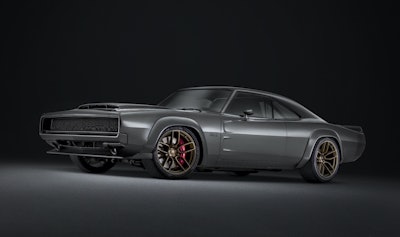 The 1968 Dodge “Super Charger” Concept, revealed on October 30, 2018, at the Mopar SEMA Show press briefing in Las Vegas, is the perfect package for highlighting the new “Hellephant” 426 Supercharged Mopar Crate HEMI® Engine and Kit.
The 1968 Dodge “Super Charger” Concept, revealed on October 30, 2018, at the Mopar SEMA Show press briefing in Las Vegas, is the perfect package for highlighting the new “Hellephant” 426 Supercharged Mopar Crate HEMI® Engine and Kit.The 1968 Dodge “Super Charger” Concept assumes a “wide body” stance thanks to front and rear fiberglass wheel flares painted “De Grigio” Grey Metallic body color. The front wheels push forward two inches to accommodate the flares and shorten the Charger’s overhang, extending the classic’s wheelbase from 117 inches to 119 inches. Front wheels are stock 20 x 11-inch Devil’s rims pulled from the Challenger SRT Hellcat, while the rears are upsized 21 x 12-inch custom-milled aluminum Devil’s wheels. The body drops 2.5 inches in the rear and 3.5 inches in the front to aggressively hug the pavement. Six-piston Brembos deliver a decisive stopping-power advantage over the 1968 brakes.
Custom fiberglass front and rear bumpers are flushed up and shortened cross-car to provide an integrated design. The custom fiberglass front chin splitter takes influence from the Demon, while the custom rear spoiler is inspired by the modern Charger R/T. The trunk key cylinder lock is shaved and the Satin Black fuel door embellished with a custom-milled aluminum “Hellephant” medallion, one of many unique design touches incorporated throughout the “Super Charger” Concept. Vehicle graphics and badging are Satin Black vinyl decals, including the “Hellephant” logo on the front fenders, “Super Charger” badging above the doors and classic tail stripes at the rear.
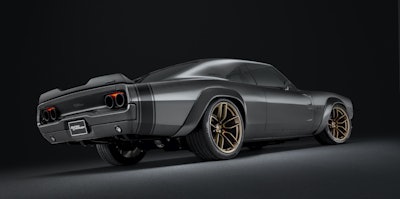 1968 Dodge “Super Charger” Concept
1968 Dodge “Super Charger” ConceptThe Product Design Office (PDO) team let their imaginations run wild at the tail of the ’68 Charger. The lower exhaust tips are eliminated and replaced with Alfa Romeo Stelvio 5-inch dual-walled exhaust tips re-engineered to run through the taillamp housing. The brake lights have been uniquely reconfigured with LED lights that glow around the exhaust tips.
Inside, door panels and interior trim are Satin Black with the unique “Hellephant” milled medallion applied on the upper door panels. The Dodge Viper steering wheel also carries the “Hellephant” medallion at its center. The instrument panel insert is “De Grigio” Grey Metallic body color and the dash is customized with a full array of Mopar gauges.
The body-color center console holds a manual shifter from the Dodge Challenger SRT Hellcat, as well as the ignition button and toggle switches for the headlamps, wipers, fog lights and hazard lights. The stock front seats have been replaced with Dodge Viper seats re-wrapped in Alcantara leather accented with red stitching and are fitted with four-point Sabelt black racing harnesses. The Dodge Challenger SRT Demon seat delete option opens up the rear and also sheds weight while making space for a custom 2-inch roll cage designed to follow the profile and harmonize with the shape of the day light opening (DLO). A Challenger SRT Demon net allows for storage of racing equipment such as helmets and gloves. A black Challenger SRT Hellcat carpet covers the rear of the interior, while the front features custom floor mats modified from the current Charger SRT and Mopar pedal kits for the Challenger.
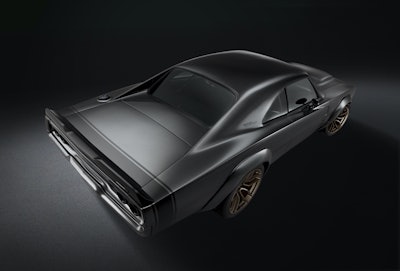 The 1968 Dodge “Super Charger” Concept assumes a “wide body” stance thanks to front and rear fiberglass wheel flares painted “De Grigio” Grey Metallic body color. Front wheels push forward two inches to accommodate the flares and shorten the Charger’s overhang, extending the classic’s wheelbase from 117 inches to 119 inches.
The 1968 Dodge “Super Charger” Concept assumes a “wide body” stance thanks to front and rear fiberglass wheel flares painted “De Grigio” Grey Metallic body color. Front wheels push forward two inches to accommodate the flares and shorten the Charger’s overhang, extending the classic’s wheelbase from 117 inches to 119 inches.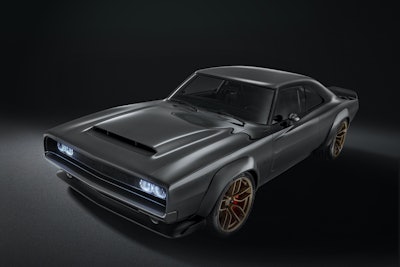 Highlights of the 1968 Dodge “Super Charger” Concept include a hood scoop based on the Dodge Challenger SRT Demon, Dodge Charger SRT Hellcat headlamps placed behind the grille and shaved door handles and drip rails, creating a clean, streamlined appearance.
Highlights of the 1968 Dodge “Super Charger” Concept include a hood scoop based on the Dodge Challenger SRT Demon, Dodge Charger SRT Hellcat headlamps placed behind the grille and shaved door handles and drip rails, creating a clean, streamlined appearance. The interior of the 1968 Dodge “Super Charger” includes the unique “Hellephant” milled medallion applied on the upper door panels, a Dodge Viper steering wheel that also carries the “Hellephant” medallion at its center and a dash customized with a full array of Mopar gauges.
The interior of the 1968 Dodge “Super Charger” includes the unique “Hellephant” milled medallion applied on the upper door panels, a Dodge Viper steering wheel that also carries the “Hellephant” medallion at its center and a dash customized with a full array of Mopar gauges.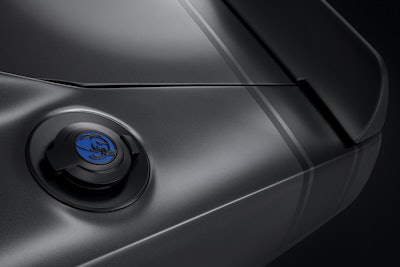 The Satin Black fuel door of the 1968 Dodge “Super Charger” Concept is embellished with a custom-milled aluminum “Hellephant” medallion. Vehicle graphics and badging are Satin Black vinyl decals, including the classic tail stripes at the rear.
The Satin Black fuel door of the 1968 Dodge “Super Charger” Concept is embellished with a custom-milled aluminum “Hellephant” medallion. Vehicle graphics and badging are Satin Black vinyl decals, including the classic tail stripes at the rear.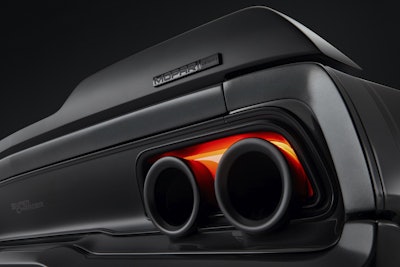 The lower exhaust tips of the 1968 Dodge “Super Charger” are eliminated and replaced with Alfa Romeo Stelvio 5-inch dual-walled tips re-engineered to run through the taillamp housing. Brake lights have been uniquely reconfigured with LED lights to glow around the exhaust tips.
The lower exhaust tips of the 1968 Dodge “Super Charger” are eliminated and replaced with Alfa Romeo Stelvio 5-inch dual-walled tips re-engineered to run through the taillamp housing. Brake lights have been uniquely reconfigured with LED lights to glow around the exhaust tips.



